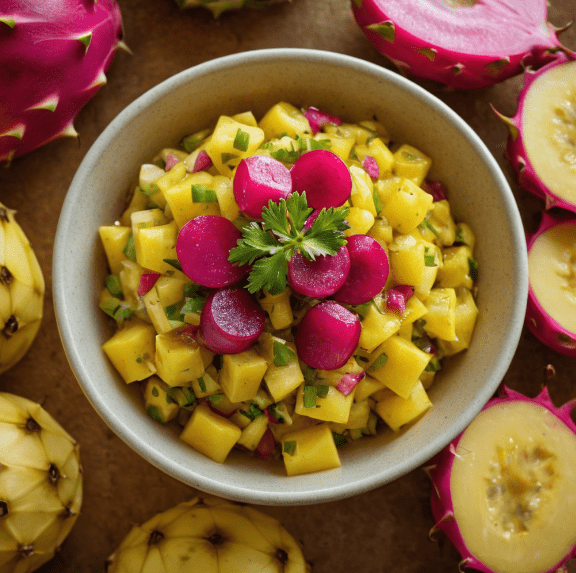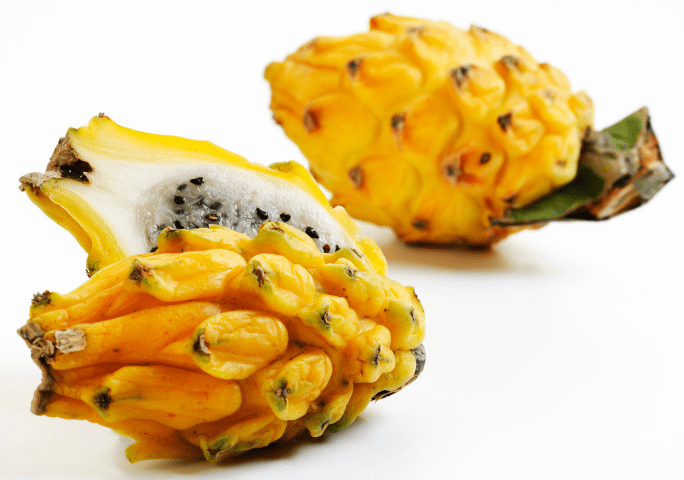Embark on a culinary adventure with our in-depth guide to yellow dragon fruit! We’ll unveil its rich nutritional profile, delve into the science behind its health benefits, and explore its versatile culinary applications. Discover why this vibrant fruit is a nutritional powerhouse and a delectable addition to your diet.
Unveiling the Nutritional Powerhouse
Yellow dragon fruit is visually arresting and packed with an impressive nutritional profile. It’s a low-calorie fruit yet rich in essential vitamins and minerals. A 100-gram serving provides a significant amount of:
- Vitamin C (18% DV): This antioxidant boosts the immune system and promotes skin health.
- Fiber (3 grams): Promotes digestive health and regularity.
- Iron (4% DV): Essential for healthy blood and energy levels.
- B Vitamins: Contribute to energy metabolism and brain function.
- Calcium (4% DV) and Phosphorus enhance bone strength.
This fruit is also loaded with antioxidants, including betalains and hydroxycinnamates, which fight free radicals, the harmful molecules linked to chronic diseases.
Science-Backed Health Benefits
1. Bolstering Your Immune System: Yellow dragon fruit is a robust immune system booster due to its high vitamin C content. Vitamin C stimulates the production of white blood cells and acts as an antioxidant, shielding the body from infections and diseases, according to a study published in the National Institutes of Health Journal: The Roles of Vitamin C in Skin Health – PMC
2. Promoting a Healthy Gut: The rich fiber content in yellow dragon fruit helps maintain a healthy digestive system. Fiber aids in bulking up stool and facilitating smooth passage through the digestive tract, which can prevent constipation and IBS symptoms, as highlighted in a review published in Alimentary Pharmacology & Therapeutics
3. Supporting Heart Health: The seeds of yellow dragon fruit are rich in omega-3 and omega-6 fatty acids, known to reduce triglyceride levels, lowering the risk of cardiovascular disease according to research published in The American Journal of Clinical Nutrition: Betalain-rich dragon fruit (pitaya) consumption improves vascular function in men and women: a double-blind, randomized controlled crossover trial.
Additionally, the fruit’s potential to decrease harmful cholesterol levels while improving good cholesterol enhances heart health.
4. Aiding Weight Management: As a low-calorie food with high fiber content, yellow dragon fruit is an excellent addition to any weight loss diet. The fiber promotes satiety, reducing the likelihood of overeating, and the low-calorie count ensures it can be enjoyed without significantly impacting daily calorie intake.
5. Enhancing Skin Health: Yellow dragon fruit contains several antioxidants that protect the skin from the aging effects of the sun and pollution. Vitamin C, in particular, enhances skin brightness and reduces the appearance of dark spots and wrinkles.
Culinary Delights with Yellow Dragon Fruit
Beyond its impressive health benefits, yellow dragon fruit offers delightful culinary versatility. This vibrant fruit can be enjoyed fresh, adding a touch of sweetness and unique texture to your meals, or incorporated into various culinary creations:
- Smoothies and Juices: Blend it with other fruits for a refreshing and nutritious drink.
- Salads: Add diced yellow dragon fruit to salads for color and flavor.
- Desserts: Create vibrant desserts, such as sorbets, fruit tarts, or even dragon fruit ice cream.
- Jams and Sauces: Cook it down to make delicious jams or exotic sauces for meat or fish dishes.
Yellow Dragon Fruit Recipes
Try this simple Yellow Dragon Fruit Salsa recipe to taste the tropics

Indulge in the vibrant flavors of this refreshing Yellow Dragon Fruit Salsa. With its vibrant hue and tangy sweetness, this salsa perfectly accompanies chips, tacos, or grilled meats.
Combine ripe yellow dragon fruit, chopped red onion, minced jalapeño, chopped cilantro, lime juice, and a touch of honey for a harmonious blend of sweet, spicy, and savory. Garnish with additional chopped cilantro for a vibrant presentation and a touch of jalapeño for a perfect accompaniment to grilled fish or tacos.
This simple yet delectable salsa will elevate any dish with its tropical flavors and freshness.
Yellow Dragon Fruit Smoothie

Ingredients:
- 1 yellow dragon fruit, peeled and cut into chunks
- 1 banana, sliced
- 1/2 cup orange juice
- 1/2 cup Greek yogurt
- 1 tablespoon honey (optional)
Instructions:
- Combine all ingredients in a blender.
- Blend until smooth and creamy.
- Serve immediately, garnished with a few extra pieces of dragon fruit or a sprig of mint for a refreshing touch.
Yellow Dragon Fruit Salad

Ingredients:
- 1 yellow dragon fruit, peeled and sliced
- 2 cups mixed greens (like arugula and spinach)
- 1/2 cup sliced cucumber
- 1/4 cup crumbled feta cheese
- 1/4 cup toasted walnuts
- Dressing:
- 3 tablespoons olive oil
- 1 tablespoon balsamic vinegar
- 1 teaspoon honey
- Salt and pepper to taste
Instructions:
- Arrange the mixed greens on a plate and top with slices of dragon fruit, cucumber, and crumbled feta cheese.
- Whisk together the olive oil, balsamic vinegar, honey, salt, and pepper in a small bowl to make the dressing.
- Drizzle the dressing over the salad and sprinkle toasted walnuts on top.
- Serve immediately as a refreshing and healthy starter or side dish.
These recipes showcase the versatility of yellow dragon fruit, from a refreshing smoothie to a zesty salsa and a vibrant salad. Enjoy experimenting with this exotic fruit in your kitchen!
Yellow Dragon Fruit Plant
The yellow dragon fruit plant, scientifically known as Hylocereus megalanthus, is a captivating species of the Cactaceae family. Distinguished by its vibrant yellow-skinned fruits and white, seeded pulp, it is renowned for its lovely and juicy flavor profile.
This climbing cactus thrives in warm, tropical to subtropical climates and requires a structure like a trellis to support its growth due to its vining nature.
The plant is adorned with large, white, nocturnally blooming flowers that are striking and fragrant, attracting pollinators such as bats and moths. Cultivating the yellow dragon fruit can be more challenging than other varieties due to its sensitivity to cold temperatures and overwatering. Still, its delicious fruit makes it a prized variety for gardeners and farmers alike.
Cultivating Yellow Dragon Fruit Plant
If you plan to venture into cultivating yellow dragon fruit (Hylocereus megalanthus), careful attention to climate, soil, and general care is required to ensure healthy growth and fruitful harvests.
Here’s how you can cultivate this exotic plant:
1. Climate Requirements
- Yellow dragon fruit thrives in warm, tropical to subtropical climates.
- It needs temperatures between 65°F and 77°F (18°C to 25°C) and should be protected from frost, as it is sensitive to cold.
2. Choosing a Site
- Select a location with ample sunlight, as the plant needs full sun for optimal growth.
- Ensure the site is sheltered from strong winds, which can damage the plant and fruit.
3. Soil Preparation
- Plant in well-draining soil to prevent root rot. Adding sand or perlite can improve drainage.
- The soil should be slightly acidic to neutral (pH 6 to 7).
4. Planting
- You can start with seeds, but using stem cuttings from a mature plant is more effective.
- Plant cuttings about 6 to 8 inches deep in the soil, ensuring some of the nodes are buried as they will root.
- Space plants about 8 to 10 feet apart to allow room for growth.
5. Support Structure
- Provide a sturdy trellis or support structure as yellow dragon fruit is a climbing vine.
- This support will help manage the plant’s weight and facilitate easier fruit harvesting.
6. Watering
- Water regularly, but allow the soil to dry out between watering to prevent over-saturation.
- Reduce watering frequency during the winter or cooler months.
7. Fertilization
- Fertilize every two to three months with a balanced fertilizer.
- You can supplement with a high-potassium fertilizer during the growing season to encourage blooming and fruiting.
8. Pruning
- Prune to remove dead or excessive growth, which helps maintain plant health and encourages more fruit production.
- Focus on maintaining a few main stems and remove smaller offshoots to direct the plant’s energy.
9. Pollination
- The flowers bloom at night and typically require cross-pollination by bats or moths. You may need to hand-pollinate the flowers without natural pollinators to ensure fruit set.
10. Pest and Disease Management
- Monitor for common pests such as aphids, mealybugs, and spider mites.
- Use organic pesticides or natural methods like neem oil to control infestations.
Embrace the exotic beauty of yellow dragon fruit in your garden. By adhering to these guidelines, you’ll reap the sweet rewards of its vibrant fruits and transform your outdoor space into a tropical paradise.
Yellow Dragon Fruit: A Fruit Worth Embracing
Yellow dragon fruit is more than just an exotic treat; it’s a powerhouse of nutrition and health benefits. Incorporating this fruit into your diet can improve digestive health, immune function, and skin vitality.
Whether consumed fresh or included in various recipes, yellow dragon fruit offers a delightful taste and numerous health advantages, so next time you’re looking for a unique and nutritious addition to your diet, consider trying yellow dragon fruit!
FAQ
Is dragon fruit keto-friendly?
Yes, dragon fruit is considered keto-friendly in moderation. It is relatively low in carbohydrates compared to many other fruits. A 100-gram serving of dragon fruit contains about 11 grams of carbohydrates, of which 3 grams are fiber, netting about 8 grams of digestible carbohydrates.
What does yellow dragon fruit taste like?
Unlike its red or white counterparts, yellow dragon fruit tends to be sweeter and has a more intense flavor. It is often described as having notes of honey and a mild, tropical sweetness that isn’t overly pronounced.
The texture resembles a kiwi, with tiny, edible seeds that add a slight crunch. Its flesh is juicy and refreshing, making it a delightful treat, especially when chilled. Overall, yellow dragon fruit offers a subtly sweet taste experience, making it more appealing to those who prefer less tangy fruits.
What are Other Yellow Fruit Names
Here’s a list of various yellow fruits that are commonly recognized:
- Banana – Probably the most well-known yellow fruit, enjoyed worldwide.
- Lemon – Known for its bright yellow color and sour taste.
- Pineapple – Tropical fruit with a tough, spiky exterior and sweet, juicy interior.
- Mango – Available in several varieties, some of which are yellow when ripe.
- Golden Apple – Also known as yellow apple, these are sweet and crisp.
- Yellow Pear – Sweeter and softer than their green counterparts.
- Yellow Watermelon – A less common variety with a sweet, honey-like taste.
- Star Fruit (Carambola) – Distinctive star-shaped fruit with a waxy, yellow skin.
- Yellow Cherry – A rarer variety of cherries, often sweet with a mild flavor.
- Apricot – Small, golden-orange fruits with a soft, tangy flesh.
- Papaya – Large tropical fruit with a sweet, musky taste.
- Yellow Kiwi – Sweeter and less tart than the green kiwifruit.
- Yellow Guava – Has a sweet, slightly floral flavor.
- Golden Kiwifruit – Known for its smooth, hairless skin and sweet flavor.
- Yellow Plum – Juicy with a balance of sweet and tart flavors.
- Yellow Dragon Fruit – Known for its sweet and honey-like flavor.
- Golden Berries (Physalis) – Small, round fruits encased in a papery husk, with a sweet-tart flavor.
- Yellow Passion Fruit – Has a tart, aromatic flavor more intense than the purple variety.
- Yellow Fig – Less sweet than the purple variety, with a milder flavor.
- Yellow Raspberry – Rare and similar in size to red raspberries but with a sweeter, milder taste.
These fruits add vibrant color to dishes and offer various health benefits, making them excellent choices for a balanced diet.























